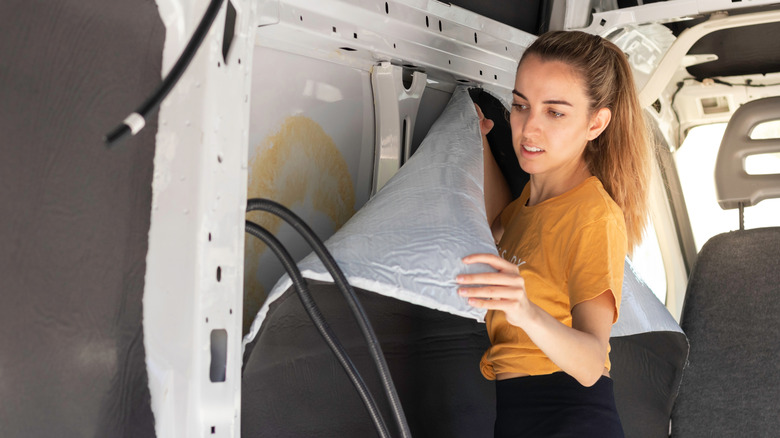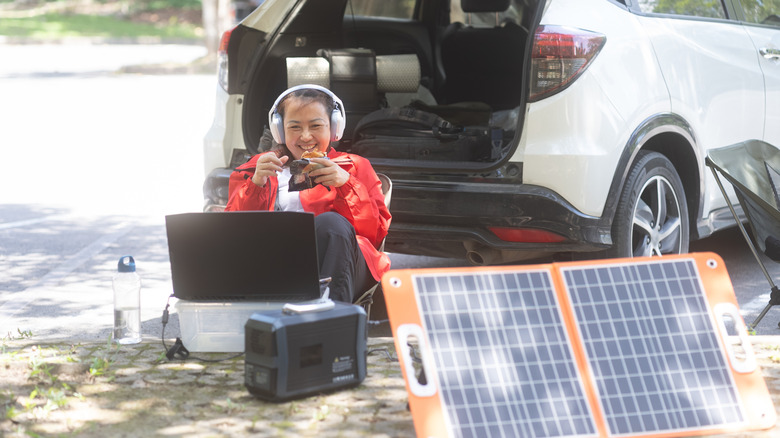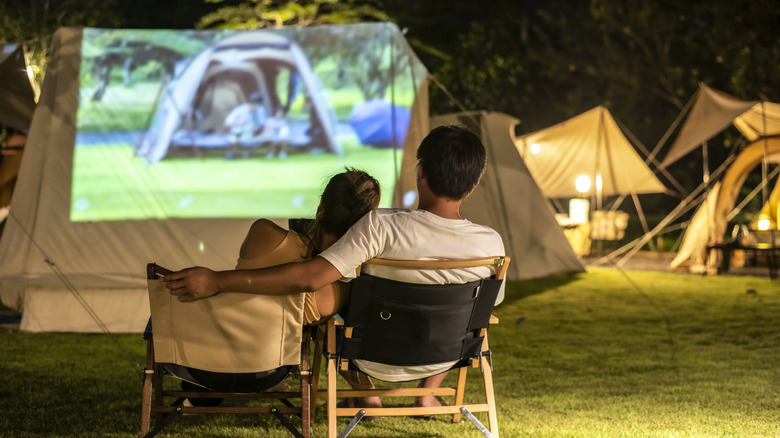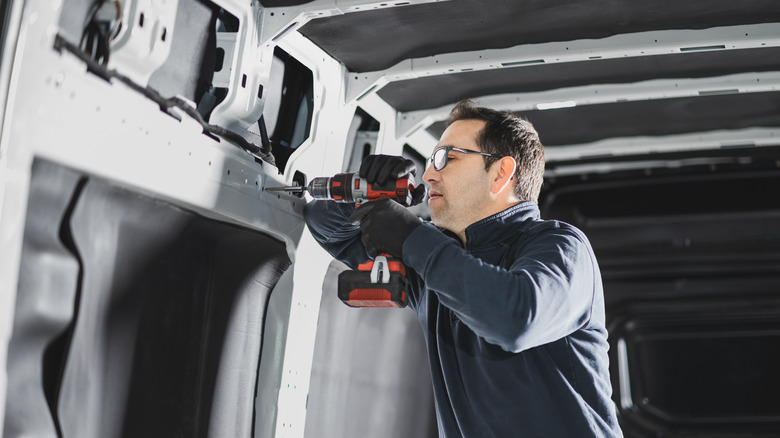5 Ways To Turn Your RV Or Van Into A Smart Camper
We may receive a commission on purchases made from links.
Ever since the #vanlife trend spread itself across social media, interest in "smart campers" has exploded. Smart campers are usually an RV, van, trailer (or "caravan" outside of the U.S.) that has been customized with clever technology to make this nomadic lifestyle more comfortable.
However, before you can get started, there a many choices that need to be made. For instance, do you want to buy a van and convert it into a living space, or would you rather make improvements to an existing RV? Do you want to build the smart camper yourself, or pay a specialist to do it for you?
If you're considering taking the plunge with a smart camper, we'll take you through the technical essentials. From choosing a van and insulating it, to better kitchens and smarter furniture, or buying more energy-efficient electronics that run off-grid, we'll highlight different products to suit different budgets. Our recommendations are based on advice from respected media outlets, industry specialists, and owner reviews — see the end of the article if you would like to know our methodology.
Temperature control: heating, cooling, and insulation
All cars get hot in summer and cold in winter, but insulating your van will make life more comfortable and reduce your energy bills. There are two main areas to focus on: mass insulation and thermal break layers. Mass insulation is used mostly for the cavities between the outer wall and internal structural pieces. Sheep's wool is a popular choice as it is a natural product, it can be easily pulled apart for small spaces, and is moisture resistant.
Thermal break layers minimize the transfer of heat through your car's metal shell and structural components. The easiest method is to use closed-cell foam, which has a foam center and reflecting foil. A popular product is Armaflex, which has an adhesive backing on one side. This makes it easy to install and is one of the most popular choices in the vanlife community. It is, however, the least effective product here and may not be sufficient for severe climates. Insulation boards, like PIR and XPS, are highly performant, and cheap. However, they're much harder to mount against curved surfaces than closed-cell foam. Regardless, they may be a good fit for larger vans and are well suited to underfloor insulation.
Heating wise, some vanlifers actually use small wood-burning stoves, but a more common choice is a diesel heater. These use little fuel and can be surprisingly quiet if well isolated. A popular brand is HCalory, with affordable products like the Compact SE for $199 on Amazon, which can be activated remotely by smart app. Adding an air conditioner system into your RV or campervan can get expensive, but the Dometic Air Distribution Box is only $160. It is non-ducted, so it should fit most makes and models, but be sure to check your ceiling measurements first. It has a 4.5 out of five-star score out of over 1,500 reviews, and users highlight the easy installation process.
Off-grid solar and portable power stations
Unless you're the kind of noisy sociopath who runs a gas generator for days on end regardless of where you're parked, you'll want a solar generator. Off-grid solar generator kits are pretty simple and most can be set up within a couple of minutes. They usually consist of four components: a solar panel, a battery, a charge controller, and an inverter. The solar panel and battery are simple enough, but people often glaze over when they hear about the charge controller and inverter. But you needn't be scared, it's quite basic.
An inverter takes the DC power your battery uses and converts it into the kind of AC power your household appliances need. It's basically a box that has a wall socket and power switch on it, but it can plug into your battery. A charge controller is a kind of hub that connects all the parts and regulates the amount of charge going from the solar panel to the battery.
These parts can be bought separately or as a kit. Some people are intimidated by the idea of connecting these parts, so all-in-one boxes are now available, to which you simply connect a solar panel. However, these all-in-one boxes are usually expensive and have limited power capacity. For instance, the highly popular Jackery Explorer 1000 – that SlashGear reviewed – comes with a powerhouse 1000W inverter and a 1002Wh battery, but at $1,000, it's not exactly a casual purchase. Something like the $219 Bluetti AC2A may be much cheaper, but with a maximum output of 300W, it will only be suitable for things like laptops and televisions — most cooking won't be possible. Regardless, these setups are a great investment and will be useful in other settings, such as blackouts, natural disasters, or camping trips.
Power efficient kitchens
For RVs and trailers, conventional wisdom has always been to cook with gas. Unless you have something like a new EV, or a trailer with an ultra-capacity battery, anything like toasters or electric ovens will just overload your inverter. If you're happy refilling gas bottles, or buying cans of butane, any camping store will have what you need. However, if you're only cooking for yourself, numerous companies now offer low-wattage cooking appliances designed not to overload your off-grid electrics.
Dash has a very cheap range of mini appliances, such as its $19 Rapid Egg Cooker, which has a 4.7 out of five Amazon rating based on more than 126,000 reviews. Dezin's highly versatile Hot Pot Electric has a claimed maximum output of 600W, with a low-power 250W mode, which should be friendly to cheaper inverters. It's currently $33 on Amazon with a 4.6 out of five rating, based on 9,619 ratings. For something more unconventional, BioLite sells ultra-efficient camp stoves that run on burning twigs and can charge USB devices — its $150 CampStove 2+ has a 4.5 out of five rating based on 583 ratings.
Fridges and freezers can also be powered by gas, but DC electric fridge-freezers are simpler and more popular. Of chief importance is a fridge that opens vertically: something with a front-hinged door will be incredibly wasteful, as it loses plenty of cold air each time you open the door. For under $500, the most popular choice on Amazon, with the biggest internal space, is the $490 F40C4TMP 12 Volt Portable Refrigerator. It has dual-zone fridge-freezer functionality and a 54-quart (51 liters) storage capacity. It's currently rated 4.4 out of five, based on 233 ratings. If your budget can stretch further, check out our list of the 5 most popular campervan fridges.
Smart furniture and storage
To live comfortably in a small area, you need to make intelligent use of space. This involves multipurpose furniture: any furniture should ideally serve two or more purposes to eliminate the need for additional objects. A front seat that swivels can provide additional seating in the living area. Couches often slide out and convert into beds. Storage Ottomans are particularly useful as they combine benches and footrests with storage space, accessed by lifting a lid.
Hinges, rollers, and sliding rails can transform a space. A footrest can be rolled elsewhere and used as a coffee table one minute, and a large step the next. A sliding cupboard door can swing upwards and have fold-out legs to provide a dinner table. Any raised platform, like a bed, can provide cavernous storage underneath and stow away things like wiring, plumbing, or smart controllers. Even a basic step can double as storage — you can slide shoes underneath or mount the footboard on a hinge for an extra cubbyhole.
Don't forget about vertical space. Beds can be placed on electric lifts, televisions can slide away, projector screens can be lowered. Or you may simply add more shelves and cabinets to areas you may not have considered, and add netting to the underside of a bed or roof to stow gear.
Daily electronics can also be integrated into furniture. For instance, the ChooChoo LED Nightstand combines a two-drawer nightstand with LED lighting, wireless phone charging, plus A/C outlets and USB charging ports. It's currently $130 with a four out of five rating, based on 63 reviews. Or the Horizon Bedside Lamp combines an ambient night lamp with a 10W bluetooth speaker, a digital clock, and wireless charging. It's currently $170 with a 4.1 out of five rating, based on 362 reviews.
Smarter gadgets
Vanlife electronics should be focused on compactness and efficiency. If something serves multiple purposes, all the better. A modern television's inputs allow it to be used as both a television and a computer monitor. Or you might consider a mini LED projector such as the TMY Bluetooth Projector for $100, which includes a screen and multi-device connection capabilities.
Only hardcore geeks would bring a full-fat desktop PC into their smart van, but a well-spec'd gaming laptop may provide a decent compromise between processing power, physical size, and battery consumption. For non-gamers, ARM-based devices (including smartphones and tablets) may be sufficient for your needs while consuming a fraction of the power of x86-based Windows PCs. Apple products have been popular with vanlifers since their switch to ARM-based CPUs in late 2020. Another popular choice is a Raspberry Pi — which can have very low power consumption — running Linux. Or you might be tempted by the latest Snapdragon laptops, running either Windows 11 or Linux.
Vanlifers who aren't afraid of some electrical work might consider adding a smart thermostat to their smart camper, and RV owners might consider upgrading their stock unit. Products like the Micro-Air EasyTouch allow remote wireless access to your air-conditioning system, letting you pre-cool your van or turn off the system from anywhere you want.
For more efficiency gains, many vanlifers opt for DC-powered devices, which draw power from your battery directly instead of using AC power from the inverter. Sylvox smart televisions are a popular choice in North America, such as this $299 22-inch model, which can run on either AC or DC, and comes with Android, Google Play, DVD, Wi-Fi, and Bluetooth. For more gadget ideas, see our article on innovative tech upgrades for the ultimate comfort in your camper van.
How our recommendations were selected
Our recommendations were based on owner reviews, with any broad commonalities between owners taken into consideration. Recommendations for electrical gadgets were based on reviews by experienced smart camper owners with access to power readouts — only products unlikely to overload an inverter were considered.
Recommendations for insulation and design were taken from accredited engineers and experienced designers. During our research, one particularly useful resource was Engineers who Van Life. The website contains extensive guides and information for members of the general public intending to do their own smart camper conversions. We also took into consideration hands-on reviews and recommendations from our team here at SlashGear.






